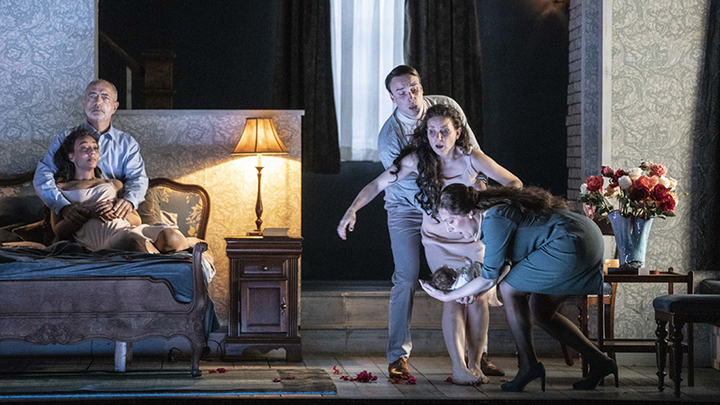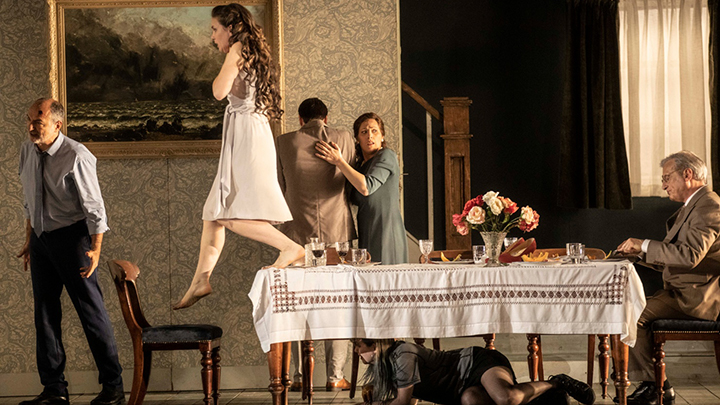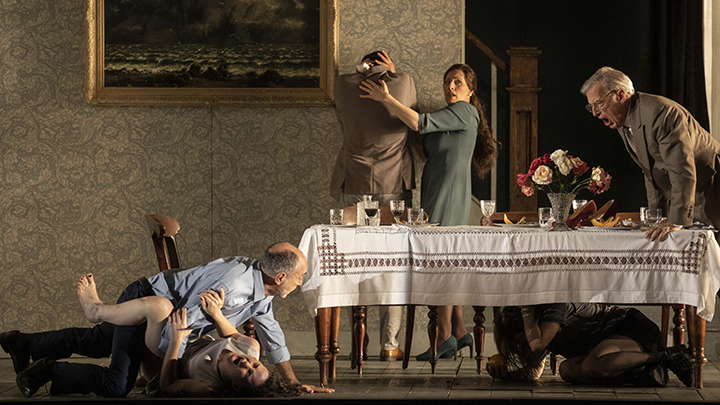Unconscious coupling – parterre field

On a Saturday afternoon in late April 1971, Metropolitan Opera Normal Supervisor Rudolf Bing addressed the radio viewers of the season’s closing Texaco Saturday afternoon broadcast with a preview of the next season, his final within the job. He assured the viewers that the Met was basically “an Italian home” and disclosed that the ultimate new manufacturing of his lengthy tenure could be Verdi’s Otello. However, he highlighted two different new productions for 1971-72: a brand new Tristan und Isolde, to star Birgit Nilsson in a reprise of her 1959 home debut, and the lengthy absent Pelléas et Mélisande. Pelléas, Bing predicted— with a candor predating the period of the humanities administrator as advertising huckster—would doubtless fail on the field workplace. He was proper.
When the run took its course the next winter, it bought poorly. So few individuals remained after the second intermission, one standing-room stalwart reported, that anybody who needed to might have sat on the stage. Bing’s prediction was partly self-fulfilled by a dreary, soporific manufacturing that appeared nearly to apologize for the opera itself. It took 1 / 4 century for a brand new Pelléas to reach on the Met, right that unhappy precedent, and on the identical time assist dissolve viewers concern, resistance, and apathy towards the work itself. The stately and really stunning Jonathan Miller/John Conklin manufacturing with its robust casts and conductors (Levine, Rattle, Nézet-Séguin), revived most lately in 2019, made it simpler for a few of us to pronounce dogmatically that if Tristan is the best opera ever written, Pelléas is the second biggest.
After all, the 2 plots are uncannily alike. A bride is married to a a lot older man however falls in love with somebody nearer to her personal age and degree of need. It ends badly. If Pelléas is dramatically unthinkable with out Tristan, it’s musically unthinkable with out Parsifal. (Let’s comply with dispense with the chestnut of nationalist musicology that denies the significance of Wagner to Debussy.) Like Wagner, Debussy seeks a music that may form a transparency and authenticity of thoughts and emotion. In contrast to Wagner, he’s served by a librettist, Maurice Maeterlinck, who can present the textual correlative redolent of the identical values of transparency and authenticity. The end result, as audiences have come to understand with a delay of solely a century and with productions that remember the opera moderately than apologize for it, is a musical, dramatic, and linguistic luminosity that does justice to the ideas proclaimed by the opera’s hero Pelléas himself: readability (clarté) and reality (vérité).

Pelléas and Mélisande search mild. In contrast to Tristan and Isolde, they personal their need and contemplate it unproblematic. They don’t fetishize the darkness (l’obscurité) that surrounds them, however they do discuss it, fear about it, succumb to it. And additionally it is a part of them. They don’t seem to be clear to themselves. Which suggests: they every have an unconscious. Because the core class of psychoanalysis, the unconscious was mapped by Sigmund Freud in 1895-96 and revealed (in The Interpretation of Desires) in 1900, the identical span of years from the composition of Pelléas (1893-95) to its premiere (1902). It resides because the innermost dimension of the person thoughts and collective tradition. It may be engaged however not recognized.
The unconscious can’t be recognized, Freud argues, as a result of its content material is pure violence: the violence constructed from the unmediated need and limitless selfishness of the toddler whose primitive and sole concern is the nourishment that’s indistinguishable from possessive love. Possessive love, even—maybe particularly—when sanctioned by society within the type of sexual constancy—harbors violence, even when—particularly when—it’s repressed. Pelléas et Mélisande explores this dynamic with a requisite mixture of ambiguity and precision distinctive within the historical past and repertory of music drama.
Which brings us to Aix-en-Provence and the 2024 revival of Katie Mitchell’s manufacturing, first seen in 2016. In a program-book interview, Mitchell explains—properly, if predictably—that her staging entails a feminist intervention that recenters the opera round Mélisande. All the time taciturn and mysterious, Mélisande is “discovered” alone within the forest within the opera’s opening scene. Like Parsifal, she has no obvious origin, id, or future; not like Parsifal, she is given none of those by the opera because it unfolds. Conventionally, Mélisande stays a pure object—of need, management, violence. Misogyny can fairly be deemed integral to the opera. The inversion of Mélisande from object to topic requires a considerable critique of the opera’s fundamental logic and argument. Can such a correction happen whereas retaining a way of recognition, homage, and certainly love for this wonderful work? The success of Mitchell’s manufacturing supplies the affirmative reply.
As Mitchell explains it, her recentering of the opera entails a restaging of the plot and motion as a prolonged dream of Mélisande. This will quantity to an over-rationalization of her personal achievement. The surreal components of the unfolding motion will show fascinating and credible with out the framing gadget of a dream. Extra about that in a second. On the outset it have to be stated that the manufacturing’s preliminary framing gadget, the motion’s preliminary set-up, is disastrous.
Hasn’t the director’s cliché of elevating the operatic curtain onto a silent opening pantomime worn itself out, if solely due to its inherent mistrust of the music itself because the guiding narrative authority? On this case, the clichés metastasize to the extent of spoof. To wit: the curtain rises on a generic resort room. A distraught, gowned bride enters. She proceeds to the bathroom. We hear the sounds of plumbing: each hers and the bathroom’s. (Let’s not even contemplate the truth that water symbolism is the basic leitmotiv of this opera.) She administers a being pregnant take a look at. She throws herself onto the mattress.
However the manufacturing recovers effectively from this “you gotta be kidding me” self-inflicted salvo. That restoration flows first from the enveloping sonic sensuality of Susanna Mälkki’s low-string guided orchestra. “Discovered” by her (presumably already) husband Golaud, Mélisande (dreaming or not) proceeds to the Scene 2 dinner desk of the Golaud household, which incorporates each the nervous and alienated younger Pelléas in addition to a silent double of Mélisande herself, an added determine who will seem convincingly at numerous moments all through.
Lizzie Clachan’s spectacular set combines a glossy, modernist villa exterior with fin-de-siècle furnishings and its analogous haut-bourgeois formal servant tradition and porcelain desk manners. Double-Mélisande features in addition to some extent of entry into the surreal elements of the staging, as marked episodically by the apparitions of individuals, our bodies, and incarnated reminiscences past the info of their empirical presence. Pelléas will seem following his dying, Mélisande following hers, and the members of the family (Arkel, Geneviève, and Golaud) will wander zombie-like rather than the designated silent figures indicated by the libretto: for instance the three homeless individuals who give Mélisande a fright on the conclusion of the important thing Act II finale within the grotto. (The refrain is lower fully.) The dream gloss shouldn’t be obligatory for this spectral world to be understood as a sequence of perceptions, projections, and involuntary reminiscences.

Mélisande-as-subject implies Pelléas as object, and definitely as object of Mélisande’s need. Express sexual consummation happens and happens early. This explicitness will essentially give a fancy inflection to Mélisande’s closing insistence that the love between her and Pelléas remained “harmless.” The argument could contain a redefinition of innocence and guilelessness themselves, away from sexual abstinence, repression, and constancy in favor of the possession and realization of true need. The love scene that the textual content focuses on Mélisande’s hair concentrates as a substitute on Pelléas’s eroticized physique, aroused by Mélisande as she sweeps her hair backwards and forwards over his torso.
The erotic power advantages from Huw Montague Rendall’s physique and method, without delay imposing and fragile, complemented additional by his costuming in two layers of sunshine linen which each protagonists spend a great deal of time unbuttoning and rebuttoning. The sensuality of Montague Rendall’s efficiency is assured primarily by his singing– an alchemy of fashion, diction, timbre, approach, vary, and lyricism that may solely mark him as the Pelléas of his era.
Montague Rendall was properly supported however not equaled by his fellow forged members. Katie Mitchell credit the 2016 Mélisande, Barbara Hannigan, with a major function in creating the manufacturing’s idea. Hannigan’s eagerly awaited 2024 substitute, Julia Bullock, was herself changed by Chiara Skerath, whose efficiency proved vocally competent and convincing dramatically. The darkish and powerful sonority of Laurent Naouri, the one vital veteran from 2016, lacked the nuance that many have delivered to the function of Golaud, however the identical qualities accentuated the cruelty and sexual violence that the manufacturing calls for of the character. Vocally, and certainly generationally, he appeared to approximate much less his youthful half-brother Pelléas and extra their mutual grandfather, the outdated Arkel, as sung mournfully by the veteran Vincent Le Texier. Lucile Richardot (Geneviève) and Emma Fekete (Yniold) rounded out the forged, the latter forged as a backpack-wielding teenager in an obvious fixed hurry to go away this troubled household behind.
After all a efficiency in a French home places further emphasis on the comprehensibility of the textual content and the parlando vocal fashion it calls for. This requirement, partnered with the work’s fundamental precept of clarté, locations an intense premium on the standard of diction. On this difficulty permit me to swing from a swoon to a curmudgeonly polemic: can the opera trade please have an pressing dialog concerning the destiny of French diction? One thing horrible has occurred right here over the past thirty or so years, and it has contaminated each singer on this Pelléas stage, regardless of the uniformly refined and clear diction emanating from (a majority of) native French audio system.
It’s concerning the consonant “r” and the distinction between speech and track. The trendy “r” of sanctioned spoken French (and a mark of Parisian and northern regional speech observe in addition to social class) is glottal and gargled. The “r” of classical vocal fashion, nevertheless, is fashioned ahead by the tongue and palate, much less rolled than the Italian “r” however, prefer it, ahead in manufacturing and thereby most hospitable to fluid vocal manufacturing and pronunciation. Consider Martial Singher or Gérard Souzay and their era, or certainly take heed to Huw Montague Rendall’s personal flawless rendition of “Phidylé” on the newly issued recording of the songs of Henri Duparc. My guess is {that a} sort of unconscious want to deliver French sung diction right down to the earthly degree of on a regular basis speech, together with the realism of movie and the diction of nice chansonniers/chansonnières (Serge Gainsbourg, Edith Piaf), has wrought havoc on the sung French “r” and, consequently, on French vocal fashion extra usually.
Images: 2024 Competition d’Aix-en-Provence © Jean-Louis Fernandez

